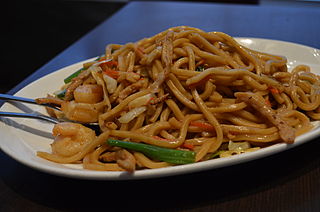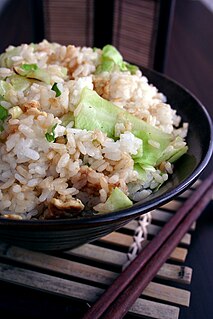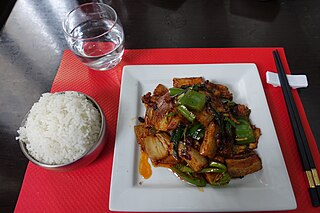
Shanghai cuisine, also known as Hu cuisine, is a popular style of Chinese food. In a narrow sense, Shanghai cuisine refers only to what is traditionally called Benbang cuisine which originated in Shanghai; in a broad sense, it refers to complex and developed styles of cooking under profound influence of those of the surrounding provinces, Jiangsu and Zhejiang. It takes "colour, aroma and taste" as its elements, like other Chinese regional cuisines, and emphasises in particular the use of seasonings, the quality of raw ingredients and original flavours. Shanghai was formerly a part of Jiangsu province; as such Shanghai cuisine is most similar to Jiangsu cuisine and may still be classified as a part of Jiangsu cuisine, although it has come into more contact with Zhejiang cuisine and foreign influences as an international city. The adoption of Western influence in Shanghai cuisine developed a unique cooking style known as Haipai cuisine(海派菜).

Offal, also called variety meats, pluck or organ meats, is the organs of a butchered animal. The word does not refer to a particular list of edible organs, which varies by culture and region, but usually excludes muscle. Offal may also refer to the by-products of milled grains, such as corn or wheat.

Fried rice is a dish of cooked rice that has been stir-fried in a wok or a frying pan and is usually mixed with other ingredients such as eggs, vegetables, seafood, or meat. It is often eaten by itself or as an accompaniment to another dish. Fried rice is a popular component of East Asian, Southeast Asian and certain South Asian cuisines, as well as a staple national dish of Indonesia. As a homemade dish, fried rice is typically made with ingredients left over from other dishes, leading to countless variations. Fried rice first developed during the Sui Dynasty in China and as such all fried rice dishes can trace their origins to Chinese fried rice.
Sweet and sour is a generic term that encompasses many styles of sauce, cuisine and cooking methods. It is commonly used in East Asia and Southeast Asia, and has been used in England since the Middle Ages. Sweet and sour remains popular in Europe and the Americas

Hokkien mee is a Southeast Asian dish that has its origins in the cuisine of China's Fujian (Hokkien) province. There are three distinct types of Hokkien mee found in Malaysia and Singapore.

Malaysian Chinese cuisine is derived from the culinary traditions of Chinese Malaysian immigrants and their descendants, who have adapted or modified their culinary traditions under the influence of Malaysian culture as well as immigration patterns of Chinese to Malaysia. Because the vast majority of Chinese Malaysians are descendants of immigrants from southern China, Malaysian Chinese cuisine is predominantly based on an eclectic repertoire of dishes with roots from Fujian, Cantonese, Hakka and Teochew cuisines.

Penang cuisine is the cuisine of the multicultural society of Penang, Malaysia. Most of these cuisine are sold at road-side stalls, known as "hawker food" and colloquially as "muckan carts". Local Penangites typically find these hawker fares cheaper and easier to eat out at due to the ubiquitousness of the hawker stalls and that they are open for much of the day and night. Penang island. On February 22, 2013, Penang was ranked by CNN Travel as one of the top ten street food cities in Asia. Penang has also been voted by Lonely Planet as the top culinary destination in 2014.

Chinese Indonesian cuisine is characterized by the mixture of Chinese with local Indonesian style. Chinese Indonesians, mostly descendant of Han ethnic Hokkien speakers, brought their legacy of Chinese cuisine, and modified some of the dishes with the addition of Indonesian ingredients, such as kecap manis, palm sugar, peanut sauce, chili, santan and local spices to form a hybrid Chinese-Indonesian cuisine. Some of the dishes and cakes share the same style as in Malaysia and Singapore which are known as the Nonya cuisine by the Peranakan.

Yangzhou fried rice is a popular Chinese-style wok fried rice dish in many Chinese restaurants throughout the world. It is commonly sold in the UK as special fried rice and in the US as house special fried rice.

Japanese Chinese cuisine or Chūka is a style of Japanese cuisine served by Chinese restaurants popularized in Japan in the late 19th century and more recent times. This style of food is different from modern Chinatown Chinese food in Japan which is considered "authentic Chinese food", e.g. Yokohama Chinatown. The Shippoku style of cooking displays heavy influence from Chinese cuisine. Many of these Chinese dishes were introduced to Japan by Chinese immigrants, others were brought in by returning Japanese soldiers from the Japanese invasion and colonization of China.

Jjamppong (짬뽕) is a Korean noodle soup with red, spicy seafood- or pork-based broth flavored with gochugaru. Common ingredients include onions, garlic, Korean zucchini, carrots, cabbages, squid, mussels, and pork. Along with Jajangmyeon, it is a popular dish found predominantly in Chinese restaurants in South Korea.
Stir-fried hawthorn is a traditional dish of Beijing cuisine, made from Chinese hawthorn fruits.

Shanghai fried noodles is a dish made from Shanghai-style noodles, which can be found in most Chinese food markets. The more commonly known Japanese udon can be used as a substitute. The noodles are typically stir-fried with beef cutlets, bok choy, and onion, or with pork and Chinese yellow chives. The dish is a staple of Shanghai cuisine, and is usually served at dumpling houses. In recent years Shanghai fried noodles have become known to western chefs, including celebrity chef Emeril Lagasse.

Singapore-style noodles is a dish of stir-fried cooked rice vermicelli, curry powder, vegetables, scrambled eggs and meat, most commonly chicken, beef, char siu pork, or prawns, yellow in colour. Singapore noodles are a Cantonese creation, and are very common in Cantonese-style restaurants and take away eateries in Hong Kong. The dish is now a very popular dish in Chinese restaurants and takeaways operated in various countries.

Chinese fried rice is a family of fried rice dishes popular in Greater China and around the world. It is sometimes served as the penultimate dish in Chinese banquets, just before dessert.

Arroz chaufa also known as Arroz de chaufa is a Chinese-fried rice dish. It is a chifa style dish, a Chinese cuisine. It consists of a mix of fried rice with vegetables, usually including scallions, eggs, and chicken, quickly cooked at a high flame, often in a wok with soy sauce and oil. It is derived from Chinese cuisine due to the influx of Chinese immigrants to Peru.

Char kway teow is a stir fried Chinese-inspired rice noodle dish from Maritime Southeast Asia. In Hokkien and Teochew, Char means “stir-fried” and kway teow refers to flat rice noodles. It is made from flat rice noodles or kway teow of approximately 1 cm or about 0.5 cm in width, stir-fried over very high heat with garlic, light and dark soy sauce, chilli paste, whole prawns, shelled blood cockles, chopped Chinese chives, slices of Chinese sausage, and bean sprouts. Other common ingredients include fishcake and belachan.

Twice-cooked pork or double-cooked pork is a Chinese dish from Sichuan. The dish's ingredients include pork, which is simmered, sliced, and stir-fried; commonly stir-fried vegetables such as cabbage, bell peppers, onions, or scallions; and a sauce that may include Shaoxing rice wine, hoisin sauce, soy sauce, sugar, ginger, chili bean paste, and tianmianjiang bean paste.

Chahan, also known as Yakimeshi, is a Japanese fried rice dish prepared with rice as a primary ingredient and myriad additional ingredients and seasonings. The dish is typically fried, and can be cooked in a wok. Chahan may have originated in the 1860s from Chinese immigrants arriving at the port of Kobe. Chahan is a staple food in homes in Japan. A variation of the dish is takana chahan. Some restaurants outside Japan serve the dish as a part of their fare.

Sabahan cuisine is a regional cuisine of Malaysia. As in the rest of Malaysian cuisine, Sabah food is based on staples such as rice with a great variety of other ingredients and different methods of food preparations due to the influence of the state's varied geography and indigenous cultures that were quite distinct from the regional cuisines of the Peninsular Malaysia. Sabah along with its neighbour of Sarawak is famous for their multi-ethnic population.

















